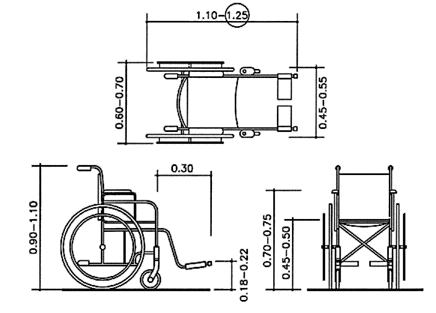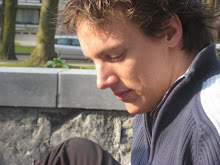Final render & Technical sheet
dinsdag 18 mei 2010
Further enhancements
As mentioned below, the suggestions for a passage with a more open feel were taken into account. On top of that, I was thinking of some modifications to keep out bikes more effectively. I came up with two:

This setup is even more simple in construction, while preserving all advantages of the one sketched above:

- An extra turn would not only make it even harder for bikes, but would also make the users leave the same direction as they came in.
- As a last resort, if real life usage shows the inadequacy to block bikes out, one or two turnpike could be added as shown below. This will definitely tackle the problem completely, however it does also erase the original elegance.

This setup is even more simple in construction, while preserving all advantages of the one sketched above:

First prototype
The first prototype was completely cut out of PU-foam by a CNC machine, available at our school. Now, my lack of experience with the machine and the program to convert 3D-models to usable CNC-models caused an incomplete prototype. However the image below shows some idea to what was intended.

The jury gave some very interesting comments on the solution and were also very taken by its simplicity and ease of use. First of all, the setup is quite confined. A suggestion was to no longer work with a solid structure, but more with frames. I liked this idea very much, as this would create a much more open feeling. These frames could be used to hold plants as well, which was suggested too. This change wouldn't affect the effectiveness of the system, but would make it more attractive.
My own concerns were: will this gate function as it is supposed to? My biggest fear was that bikes still would be able to be forced through.

The jury gave some very interesting comments on the solution and were also very taken by its simplicity and ease of use. First of all, the setup is quite confined. A suggestion was to no longer work with a solid structure, but more with frames. I liked this idea very much, as this would create a much more open feeling. These frames could be used to hold plants as well, which was suggested too. This change wouldn't affect the effectiveness of the system, but would make it more attractive.
My own concerns were: will this gate function as it is supposed to? My biggest fear was that bikes still would be able to be forced through.
Meeting the objectives - basic idea
My idea to meet the new set of objectives works as follows:


How are bikes declined access (and wheelchairs allowed):
- Take a rough profile of a wheelchair (with user)
- Drag it through a solid block with a very short turn


How are bikes declined access (and wheelchairs allowed):
- The passage is at its smallest at about 1.1m, which is the height of the handlebars on regular bike.
- There is a very short turn, which is very hard to impossible to take with a bike.
- It is quite narrow, so the bicyclist can't walk beside his bike, making it very hard to push it through.
- There's extra space provided for the wheeling action. The danger of hurting hands while passing through is hereby reduced.
- In the short turn, some extra leg space is built in. The feet of a wheelchair user make the biggest circle while turning. So by creating leg space at the bottom, the overall turning radius is kept at a minimum.
- No force has to be applied anywhere, everyone can just wheel or walk on.
- The initial profile doesn't reveal any intention towards specials efforts for the disabled or keeping bikes out.
Redefining the objectives
The existing solution did not only lack ease of use. When we take a closer look to the problem, there are other flaws: it sends a (somewhat too obvious) message of keeping some people out and even more so keeping access available to the 'disabled', it doesn't allow a fluent passage of people.
- Wheelchair users do not like to be stigmatized (yet again) by a gate that clearly is designed to allow them access, while keeping others out
- A system which allows only one person at a time go through, will fail with large crowds and will cause congestion
- The system should be easy to use: no or very little force to be applied
- No clear distinction between those who can and those who can't get access
- The system should allow a smooth passage of numerous visitors
First idea
The objective is to allow regular pedestrians and wheelchair user access to certain areas (sport terrains, parks, ...), while keeping bicycles and motorcycles out. This challenge was laid upon us by the city of Kortrijk, which already has a solution, however not an optimal one. It is shown below and is called 'de klauw'.

My first idea was to simply improve this setup, as it already does quite a good job. The main problem is the force which the wheelchair user has to apply to open and close the claws. A solution would be to make this happen automatically. Since no electronics or machinery are allowed for this challenge, I thought of using the moving weight of those passing through. A mechanism underneath the setup could open the claws to one side where a force is applied by the weight of the user. The force moves to the center of the claws, causing it to open to the other side.

My first idea was to simply improve this setup, as it already does quite a good job. The main problem is the force which the wheelchair user has to apply to open and close the claws. A solution would be to make this happen automatically. Since no electronics or machinery are allowed for this challenge, I thought of using the moving weight of those passing through. A mechanism underneath the setup could open the claws to one side where a force is applied by the weight of the user. The force moves to the center of the claws, causing it to open to the other side.
maandag 29 maart 2010
Bike & wheelchair dimensions
Bicycle Dimensions
Dinbelg Data: (Dinbelg: Dimensions of/for wheelchair users)
Technical Data:

(http://www.un.org)
Critical wheel chair dimensions:
General dimensions on Accesscode.info
- Vandewalle: vehicle dimension laws (Max Bicycle Width: 75cm)
- WikiAnswers: Average bicycle (Average Bicycle Width: 65cm & Length: 180cm)
Dinbelg Data: (Dinbelg: Dimensions of/for wheelchair users)
Width of passage | 80 minimal |
|
| 90 optimal |
| Vertical reach | 120 maximal |
| Bend down | 40 minimal |
| Turning radius | 150 wheelchair user |
|
| 190 with companion |
| Operation controls | 90 – 120 cm |
| Supporting bar | 85 – 90 cm |
Technical Data:

(http://www.un.org)
Critical wheel chair dimensions:
General dimensions on Accesscode.info
Abonneren op:
Posts (Atom)



